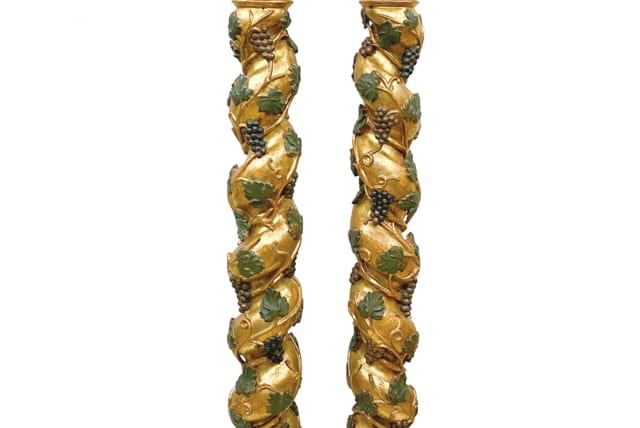Vatican hides ancient Byzantine relics that are divine heritage of Jews and Christians - opinion

"Baldwin’s Treasure" is a premier collection of Byzantine sacred antiquities, including rare Christian and Jewish objects, currently held discreetly in Vatican museums.
Ever wondered what was in the Vatican Secret Archives, or the Pope’s Treasury Collection?
“Baldwin’s Treasure” is the premier collection of sacred antiquities made of silver and precious gems from all over Byzantium. These include the finest works in ivory and enamel, jade, gold leaf, and glass. Has anyone ever heard of this? Probably not, but those who have are in the company of an elite few. This article is about a mysterious and enigmatic collection of ancient, rare objects belonging to Christian and Jewish heritage.
A little background: The Byzantine (Eastern Roman) Empire was in power about an era after the fall of Jerusalem and Israel to the legions of Rome. It was a period that spanned from around the 4th century CE to the mid-15th century, more than 1,000 years. The Byzantine Empire, with its capital in Constantinople (modern-day Istanbul,) was a major world power that extended to almost half the world, with a total population of more than 26 million people. It is during this period that Baldwin’s Treasure was accumulated.
Where do most of the Byzantine-era remnants reside today? There are several specific locations that keep these ancient relics. Museums, including those at St. Marks in Venice, the Metropolitan Museum of Art in New York, the Greek Museum of Athens, the British Museum, and of course the Vatican Museum in Rome are at the forefront. Indeed, the Vatican Museums have an extensive collection of Byzantine art, including mosaics, icons, and liturgical objects.
While the primary focus of their Byzantine collection is on Christian art, there are items of Jewish origin or relevance within that collection, especially considering the historical presence of Jewish communities in the Byzantine Empire. In fact, Jews became quite numerous and had significant roles throughout the Byzantine Empire.
As the director of the Museum Heritage Projects, I am currently working with this collection at the Vatican with the aim to bring it all out of captivity (as it were,) and film for the first time the various silver statues, chalices, and other precious objects of Christian cultic use. This also includes many examples of Jewish religious antiquities, such as goblets and candlestick lamps made of gold glass with designs worked in gold foil.
Jewish imagery in "Baldwin’s Treasure"
Some of these antiquities show authentic Jewish imagery, including an open Torah ark with rolled scrolls on shelves flanked by the ritual implements of the temple in the upper zone and other scenes. There are other glass vessels with Jewish images – including a menorah, shofar, lulav, birds, lions, and incense shovels – that were also made in the mid-fifth to mid-seventh century in the area of Syria and Jerusalem itself.
Hundreds, if not more, of these sacred ritual objects were to be found in Constantinople from the 6th to 13th centuries, including some of the oldest items that provide testimony to the Jewish origin of Christianity. As such, they are of tremendous value.
A collection of these ritual objects became known as “Baldwin’s Treasure” – named after the knight, Count Baldwin IX, who later became the first emperor of the Latin Empire of Constantinople. After ruthlessly leading the Fourth Crusade, despoiling the churches of their relics and their treasuries, and then massacring the Christian Orthodox population there at the beginning of the 13th century, Baldwin proceeded to send by ship many of his precious holdings to political allies, mainly to the various popes and rulers of Italy at the time.
His main target was the infamous Pope Innocent III, and since Baldwin knew what he liked, namely exquisite metal works of ivory and enamel, the pope received many “marvelous gifts” in the early 13th century. All of this is according to the pope’s own letters and epistles written in medieval Latin (which I have copies of,) specifying precious religious objects of cultic use, both Christian and Jewish.
This priceless collection was stored for many centuries on the grounds at St. John the Lateran Cathedral in Rome and then discreetly dispersed in small shipments to the various Vatican museums by Pope John XXIII in the late 1950s and in 1963. The process was carried out in this fashion in order not to raise unwanted attention. Then, in 1970, this shipment took place one last time by the order of Pope Paul VI with respect to the remnants of “Rome’s most precious sacred relics.” The majority are all now located in one place again.
I have met with many of the leaders of the Jewish community in Rome in order to raise awareness, and I believe that they would theoretically claim (symbolic) ownership of the Jewish part of that collection if/when the time comes. Throughout their history, the original Byzantine Greeks actually self-identified as Romans and the Roman Jews of today trace their lineage back seven generations to those expelled from Spain during the Spanish Inquisition.
People approach me and ask: What is to be the fate of these sacred relics? Are they to be preserved in darkness forever? Most experts agree with me as to where they might be found at the Vatican today. Byzantinists and other experts in medieval collections have noted that because these are in fact rare imperial gifts, the bulk of Baldwin’s Treasure today is most likely to be found as part of the Vatican’s Treasury of St. Peter’s Collection or Pope Francis’s personal Papal Heritage Collection, or parts of both.
The ultimate objective is to open the doors and pave the way, i.e., continuing my use of “soft diplomacy” for other Late Roman objects to be taken out of preservation – namely, to be restored and put on display as well. A noble cause indeed!
Since May is actually Jewish American Heritage Month, I am convinced that in a bizarre and absurd world, bereft of moral compass, now is surely the time for all of us to behold our divine heritage once again.
The writer is the director of the Museum Heritage Project (Rome,) and the author of The Vatican and ME – Unlocking the Divine Treasures Inside. He is a biblical archaeologist and president of Moskoff-Media (Israel,) MMLC. Contact: office@harryhmoskoff.net.
Jerusalem Post Store
`; document.getElementById("linkPremium").innerHTML = cont; var divWithLink = document.getElementById("premium-link"); if (divWithLink !== null && divWithLink !== 'undefined') { divWithLink.style.border = "solid 1px #cb0f3e"; divWithLink.style.textAlign = "center"; divWithLink.style.marginBottom = "15px"; divWithLink.style.marginTop = "15px"; divWithLink.style.width = "100%"; divWithLink.style.backgroundColor = "#122952"; divWithLink.style.color = "#ffffff"; divWithLink.style.lineHeight = "1.5"; } } (function (v, i) { });

